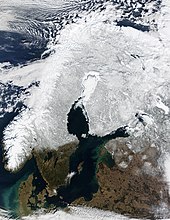Fennoscandinavia

Fennoscandinavia , also known as Fennoskandia or Fennoskandia , is a name for the northern European peninsula, which is made up of Finland ( Fenno- ) and the Scandinavian peninsula ( -scandia ) as well as Karelia and the Kola peninsula . In a regional geological context, this area, with the exception of the north-western ( Caledonian ) part of the Scandinavian Mountains , is referred to as the Fennoscan Shield or the Baltic Shield .

The Finnish geologist Wilhelm Ramsay introduced the term in 1898 (according to another source not until 1900) and justified the delimitation of the area with its geological-geographical unit. What is meant is the peninsula, which is delimited from the rest of the European mainland by the North Sea and the Baltic Sea as well as the line “ Gulf of Finland - Lake Ladoga - Lake Onega - White Sea ” (cf. White Sea-Baltic Sea Canal ).
literature
- Hans Hausen: The History of Geology and Mineralogy in Finland 1828-1918 . Helsinki 1968
- Olaf Holtedahl : Geology of Norway . Oslo 1960
- Wilhelm Ramsay: Fennoskandias ålder. In: Fennia. 40. 1917, No. 4, pp. 1-21
- Hannes Saarinen: From the Russian border march to the Nordic state. On the perception of Finland during the Weimar Republic . In: Yearbooks for the History of Eastern Europe , New Series, Volume 53, No. 3, Festschrift for Edgar Hösch (2005), pp. 364–383 ( JSTOR 41051448 )